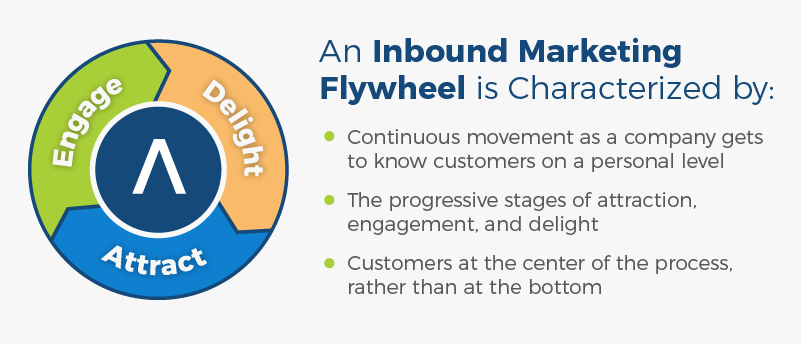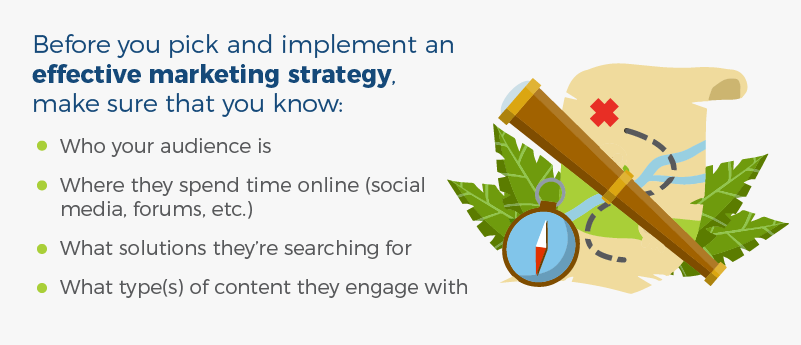Inbound marketing can be successful for small businesses and enterprise companies alike. If you’re wondering how to grow your business sustainably, taking a crash course in inbound marketing strategy can help. Ready to get started?
Striventa’s inbound marketing series is the perfect introduction to both simple and sophisticated marketing concepts for business owners. The purpose of this marketing education isn’t to make you feel overwhelmed. It’s to empower you to attract the perfect customers who want to return to your business year after year. That’s our kind of excitement!
Now that you’ve learned what inbound marketing is, you’re ready to explore more detailed concepts of how to make it work for you and your team. Discover how to attract consumers’ attention through the right foundation, mindset, and tools. In this blog, we’ll look at the following,
- The Inbound Marketing Flywheel
- How to Attract Attention to Your Business
- Why You Should Know and Review Ideal Customer Personas
- Popular Attraction-Based Marketing Tools
- Best Practices that Help Build Attraction
The Inbound Marketing Flywheel
What makes inbound marketing so unique? With inbound marketing, the process by which buyers move through the customer journey is different than traditional sales models. Older versions of the sales model are characterized by:
- An extremely large pool at the top of the funnel
- Seller-focused automation tactics and time-savers
- A linear progression as customers engage, convert, and buy
- Verbiage like “inquiries, leads, opportunities, and sales”
Many critics refer to the traditional marketing funnel as outdated and ineffective. This is because the traditional model emphasizes marketing and sales efforts without considering the customer.

In contrast, industry leader Hubspot promotes the inbound marketing flywheel. This new picture overturns the problems of the old funnel and creates ongoing momentum. An inbound marketing flywheel is characterized by:
- Continuous movement as a company gets to know customers on a personal level
- The progressive stages of attraction, engagement, and delight
- Customers at the center of the process rather than at the bottom
According to Hubspot, “The flywheel model is a more comprehensive, unified way of representing the forces affecting your company’s growth.” This updated, modern model accounts for how real people make real decisions. In turn, businesses can continuously leverage those customers and adapt to changing behaviors.
How to Attract Attention to Your Business
In the world of marketing, there are plenty of ways to attract attention to your business, but a few ways are more successful than others. We’ve all encountered marketing content that feels offensive, aggressive, or somehow misleading. These tactics tend to repel, rather than attract, the right leads. On the other hand, the right message at the right time in your search can feel super helpful!
Attracting positive attention to your business should be the main goal for junior and senior members of the company alike. Keeping your efforts focused and specific can help you gain more traction in a saturated market. Follow these foundational tips to help your team get started with attraction marketing.
- Thoroughly research your customer base. To attract, engage, and delight, you need to know exactly who you’re trying to reach with these efforts. We’ll discuss more about ideal customer personas a bit later, but the key point here is ensuring that your entire team has the time and resources they need to fully understand your audience.
- Offer the solution to a pain point. Want to get ahead quickly in the race to attract new leads and customers? Always provide value and expertise in your marketing efforts. Proactively address questions like, “Why do I need this?” and “How does it make my life easier?”
- Get to know your business in new ways. Leaders who attract also know the importance of innovation. Do you have a rich understanding of what your business represents both today and in the future? Start to know and focus on these pillars inside and out.
Adopt a “Customer First” Mindset
Even though businesses may want to attract new consumers, it’s easy to get sucked into a business-first strategy. Yes, your services might be helpful and your messaging effective, but if it’s exclusively about you, customers will pass right by.
A customer-first strategy involves creating a “business plan centered around meeting customer needs and creating delightful brand experiences.” While it may take time to develop, this type of strategy is highly useful when it comes to attracting the right people.
Do you want to start putting the customer first through your inbound marketing strategies? Here are a few tips:
- Ask customers what they really think. Surveys and feedback instruments can be powerful tools that show whether you’re striking a chord or pushing people away.
- Be transparent and honest. Are you testing new features or improving old ones? Involve customers (and even employees) in opportunities to engage with improvement. Open communication builds trust and, in turn, creates more attraction.
- Include the customer mindset in team-building efforts. Help employees understand the big picture and that they’re working toward a common goal. Remind them of important company values that are in place to put the customer first.
These strategies, along with many more, can help form a united front when it comes to serving customers with your very best. Start to slowly incorporate a few customer-focused initiatives on your team, and watch your attraction rates improve.
Why You Should Know and Review Ideal Customer Personas

In Section 4 of our inbound marketing guide, we highlighted the need to develop accurate buyer personas. These semi-fictional representations show a company what its ideal customer really looks like. Buyer personas define a target audience that includes key characteristics like location, buying behavior, and more.
Buyer personas also include demographic information and showcase an ideal customer’s desires and goals. All of this data is critical for pointing out where customers are and how they’re searching for solutions. Knowing and understanding ideal customer personas is important because it eliminates guesswork about your customer base. Do you want to spend valuable time, energy, and resources creating inbound content that doesn’t hit the target? Of course not!
How Do You Decide on a Great Marketing Strategy to Attract Customers?

When it comes to attracting new business, buyer personas can pave the way for success. Although your ideal customer avatar might technically be fictional, the information that it provides is rooted in truth. Before you pick and implement an effective marketing strategy, make sure that you know:
- Who your audience is
- Where they spend time online (social media, forums, etc.)
- What solutions they’re searching for
- What type(s) of content they engage with
The answers to these questions can help you zoom in on specific techniques and get measurable, actionable data.
Popular Attraction-Based Marketing Tools
Once you know who you’re targeting, the next step is to make sure your content shows up for them. There are a variety of strategies and methods you can use to get more eyes on your business.
Search Engine Optimization (SEO)
Search engine optimization, commonly referred to as SEO, can help you skyrocket your results in popular search tools like Google. This inbound method is powerful because it ensures that your content is seen by people who are actively looking for similar solutions and information.
Search engine optimization starts with a foundation of keyword research, but it goes far beyond that. SEO also addresses user intent, site speed, security, mobile compatibility, backlinks, and more. Some businesses may also focus on local SEO to improve search results and lead conversion in their own city or town.
Blogging
According to Optin Monster, blogging is one of the best ways to attract a loyal audience of dedicated subscribers, customers, and fans. A company’s blog often serves as the gateway to other forms of gated content. Thus, it should be professional and communicate a consistent brand message, voice, and style.
Blogs provide a way to attract organic pageviews. Since blogs are content hubs, you can regularly update them with fresh, relevant content for your potential customers.
One of the best ways to go about blogging for your business is through the 10x pillar structure. The 10x pillar page structure offers a way to do this in an expansive way by focusing on a core service or product you’d like to promote and covering all of the related material in a comprehensive piece, including chapters and blogs. The 10x pillar page structure is 10 times more creative, informative, and enjoyable to read for your audience and offers unlimited content possibilities for your business.
Social Media
Although it’s incredibly fast-moving, many businesses successfully attract customers through social media.
Social media marketing is an incredible way to stay engaged with your target audience. In addition to publishing posts with your most valuable content pieces, companies can also take advantage of social listening. This means hearing what customers have to say in real-world contexts – talk about a plethora of valuable information!
You can also take customer service inquiries through social media. If audience members see that a company is dedicated to receiving feedback and helping out customers, they may be more likely to connect or convert in other ways.
Website
Is your site speed dreadfully slow? Is your mission statement hidden beneath layers of words and complicated phrases? Does your website have a user experience journey to help customers know exactly what you do and how you can help?
These answers can reveal a great deal about your website’s potential for attracting new customers. Slow loading speeds, murky language, and hidden calls-to-action make it difficult for website visitors to know exactly what you’re about and how you can help them.
To attract new visitors through your website, simplify the design and place conversion options (like forms and opt-ins) on key pages. If you can add a self-service option, make it easy for customers to get in touch if they have questions. It’s also worth hiring a designer for a visually pleasing site that’s not too bold or distracting.
Paid Inbound Marketing Options
Although there’s been debate, paid options like Pay-Per-Click (PPC) are deemed by many experts as inbound (rather than outbound) marketing channels. Investing in paid inbound options does require skill, budgeting, and research, however. Targeted ads meet customers in their moment of search and direct them to additional content that adds value.
In a new age of PPC and targeted ads, paid inbound channels are a new avenue for any business looking to increase attraction.
Best Practices that Help Build Attraction
All industries can leverage the power of inbound marketing to attract potential leads, including business-to-business (B2B) companies, business-to-consumer (B2C) corporations, and even nonprofits or educational institutions.
To make inbound marketing work no matter the niche, there are some best practices that any marketing team can apply. Top suggestions include:
- Having a rich understanding of the inbound funnel or flywheel
- Implementing a lead-scoring system to qualify prospects
- Ensuring a cooperative and mutual relationship between marketing and sales
- Setting relevant key performance indicators (KPIs) and metrics
While many of these practices happen behind the scenes, they set the tone for the creation of high-level marketing content that meets buyers right where they are. Without unity and team buy-in, your company’s message can easily get lost, making it harder to attract customers.
Grow Your Business with Attraction-Focused Marketing
At Striventa, we see inbound marketing as the means by which all growth strategies are unified. As a result, our team of experts is committed to helping you attract more customers, whether you’ve been in business for a few months or a few decades.

